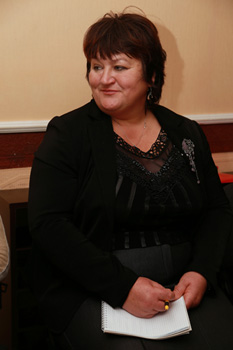
Olena Bilchenko
The Teaching with Testimony in the 21st Century program in Ukraine wasn’t Olena Bilchenko’s first experience teaching with the Visual History Archive. But the program gave her the opportunity to develop her own lessons for the first time, and she emerged with new skills and feeling a personal connection to Holocaust survivors and witnesses.
Bilchenko teaches history, law and ethics at Nobokonstyantynivska School in Slavske, Ukraine. She was one of 15 educators who were part of the 2102 Teaching with Testimony cohort in Ukraine. Teaching with Testimony in the 21st Century is a two-year program that incorporates workshops, mentoring, and community building to prepare secondary school educators to search for and utilize testimony from the Visual History Archive, as well as digital learning tools such as IWitness.
Teachers convene for an initial training session in which USC Shoah Foundation’s local liaisons provide instruction in using the Visual History Archive, building lessons and activities around the testimonies, ethical video editing, and other topics. Participants pilot the testimony-based lessons they’ve created in their own classrooms over the next year, and then reunite to present their lessons to next year’s cohort and receive feedback.
The follow up session was held Aug. 7-8 in Slavske, Ukraine, in the Carpathian mountains – two years after the initial training session in Prague. The follow-up session was delayed several times because of the political turmoil in Ukraine.
Bilchenko had already used USC Shoah Foundation’s Ukrainian-language teacher’s guides Encountering Memory and Great Famine 1932-1933: Human Dimension of Tragedy in her classroom, but wanted to learn how to create her own testimony-based lessons. She said the initial session in Prague in 2012 gave a good introduction to the theory and practice of teaching with testimony as well as how to edit video clips.
“Due to content-rich lectures and practical activities by Anna Lenchovska, Martin Smok and Olexander Voitenko we have not only gained theoretical knowledge but became specialists on video editing and were ready to work with video testimonies technically and practically,” Bilchenko said.
The most exciting part of the session was watching testimony– when the participants could “plunge into history, feel the problems and pain of a person that has told her or his story,” she said. She said she lost track of time while watching testimony, because she was so engrossed in the interviewees’ stories and emotions and wanted to watch more and more.
Bilchenko created a lesson that she can teach as part of Ukraine’s annual “first lesson” at schools across the country. This year’s theme is “Ukraine is United.” The lesson should address how Ukrainians can live together peacefully in a multicultural society, how to gain friends and support each other, she said.
She had already used the testimony of Mirgazim Sabirov, a Ukrainian Tatar who helped save Jews in Ukraine, in other lessons, and was impressed by his attitude that helping Jews was a simple, “everyday life issue.” He is an example of tolerance and humanity, she said.
“A witness is saying that before the war Ukrainians, Jews, Tatars and other ethnic groups lived together. It looks like, for him, the other way around would be surprising,” Bilchenko said. “The issue of ethnicity was not important, but rather the relations between people – friendship, neighborhood, solidarity and help, responsibility.”
Students respond well to testimony because they have grown up with visual learning, and Bilchenko’s class was no exception, she said. After watching a clip of Sabirov’s testimony, they engaged in active discussion about what he said and parallels with current events.
Through testimony, students can critically analyze what they have heard and learn to compare, make conclusions and ask questions. Video testimonies help to make the lesson not only interesting, but content-rich, with great educational potential for both students and teachers, Bilchenko said.
“Using video testimonies in comparison or in combination with other sources will help teachers not only formulate knowledge, but to develop skills and literacies, to form a person that not only thinks critically, but also acts ethically,” Bilchenko said.